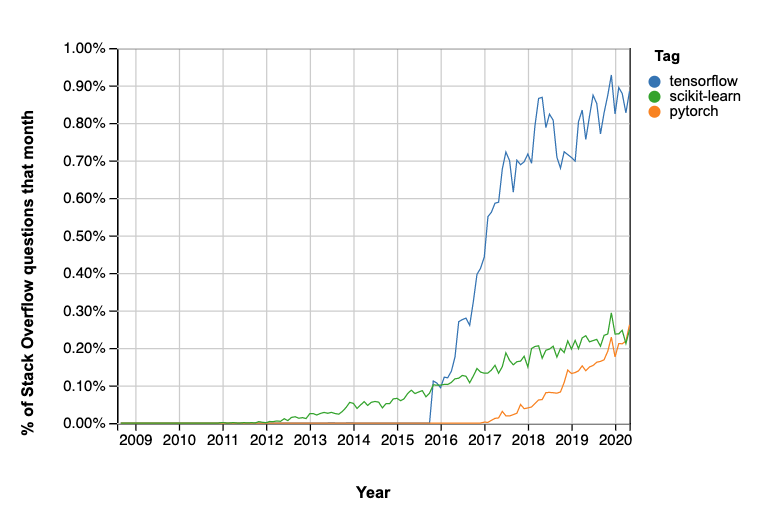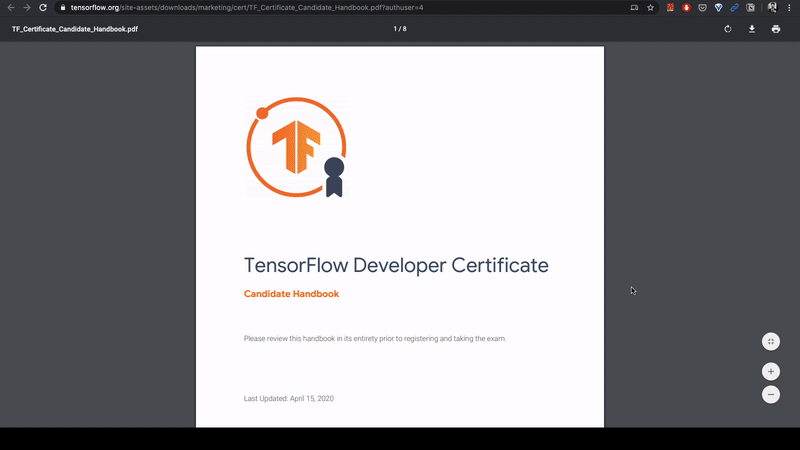On March 12, this year, the TensorFlow team introduced the TensorFlow Developer Certificate Exam.
Cut to June 13, and I am TensorFlow Developer Certified. ✅
So what happened in this 3-month long gap?
After honoring all my business and personal commitments, I managed to take off one month to prepare for the exam. After studying all the details of the exam, I created a learning plan to get myself exam-ready in 14 days.*
That’s all cool – but what is TensorFlow?
The gist: TensorFlow is an end-to-end open-source machine learning platform. It has a comprehensive ecosystem of libraries, tools, and community resources that lets ML/AI Engineers, Scientists/Analysts build and deploy ML-powered applications.
Google, Airbnb, DeepMind, intel, Twitter, and many others are currently powered by TensorFlow and it helps them solve a wide gamut of problems.
Now, I am not a certification evangelist. But since I was already using and following TensorFlow so closely as a Data Science Enthusiast it got my attention.
It has been an amazing learning streak and I am here to share all the nitty-gritty details of what the program is, how I did it, and how you can do it too!
What is this certificate program about?
The certificate is an official validation confirming your proficiency with TensorFlow with respect to solving deep learning and ML problems in the AI-driven job market.
If you’re someone who has got the skills to develop those Deep Neural Networks and solve problems with it, you can take the exam to differentiate yourself with the certificate.
Oh, snap! Not another Certification Program…😓
Why should you take the exam?
Firstly, this is not like the certification where you watch a few 2–3 minute-long video lectures and take a quiz of multiple-choice questions and get yourself certified. This will require you to code and solve a class of problems that you have (must have) prepared for.
Secondly, how many times have you thought of learning/mastering a new library or technique and then dropped the plan midway? Almost 99% of the time.
For me, the certification worked as the destination for my learning journey. I had some experience using TensorFlow but this came in as a challenge to work on problems that I hadn’t actually solved myself.
Thirdly, you should keep monitoring the technology space in your field at least. So here is a trend from StackOverflow that shows how TensorFlow is being used by a huge number of users accounting for ~90% of the questions on the platform:

Lastly, I feel that Google always provides value to its users/developers. I believe the way they have structured the exam makes it worth trying, as it validates your skillsets and adds weight to your profile.
OKAY! I’m sold, can you tell me what am I supposed to do in this exam?
Exam Walkthrough
The exam is an online performance-based test where you are provided with questions to solve by building TensorFlow models within a dedicated PyCharm environment.
You can take this exam from your computer that supports the PyCharm IDE requirements. You’ll need a reliable internet connection, and you can take the exam at whatever time suits you (I started mine at midnight).
The exam tests your ability to solve problems like Image classification from real-world images, Natural Language Processing, and time series forecasting using Tensorflow 2.x.
You can take up to 5 hours for the exam. If you exceed the time limit, the exam will be auto-submitted and you will only be graded for the questions for which you have submitted and tested your model.
You are allowed to use whatever learning resources you would normally use during your ML development work.
Exam Cost: Each attempt costs you $100 USD.
Ah-hah! so how did you prepare for this scary long exam?
How I started preparing for the Exam
The first thing I did was spend a good amount of time studying the exam itself. The TensorFlow team provides you with this comprehensive handbookthat tells you every detail about the exam and what skills you should master before taking it:

After studying the exam, I designed a curriculum for myself to cover every skillset that is mentioned in this handbook.
Next, I set myself up with a schedule so that my work engagements didn’t push me off track and I prioritized learning for those ~20 days.
And that’s all – I started preparing for the exam using this curriculum comprised of these recommended and useful resources:
 Link to my compilation of resources: https://www.notion.so/15049893501f4387893a5de0059ef8a5?v=9154c52a61494668b12802f157bce0d4
Link to my compilation of resources: https://www.notion.so/15049893501f4387893a5de0059ef8a5?v=9154c52a61494668b12802f157bce0d4
[Imp]: Learning Curriculum — Review of all the resources I used to pass the exam
For someone new to Tensorflow or Machine learning, the handbook might portray a terrifying picture. But having a plan and setting up a schedule will get you through. Here’s the curriculum that will prepare you well for the exam.
The Tensorflow team again did an amazing job of suggesting the resources based on your familiarity with Machine Learning. On top of that, I had been following a few books and playlists that helped me a great deal to cement the fundamentals in my brain and helped me go beyond the exam requirements themselves.
I have also reviewed all these resources that I used with a scoring scale of 5, based off the following qualities:
- Usefulness — to pass the exam
- Learning Value — might not have a direct effect on the exam results but will help you build a strong foundation and work on more complex problems.
Here’s the list of resources along with the time and cost that each will incur:
1. Coursera’s TensorFlow in Practice Specialization
2. YouTube Playlists on Machine Learning Foundation by Laurence Moroney
3. Hands-On Machine Learning with Scikit-Learn, Keras, and TensorFlow, 2nd Edition
4. Other Useful YouTube Playlists
These are a few playlists that I went over to get a good grip over each of the required concepts:
- MIT 6.S191: Introduction to Deep Learning:
- Usefulness 3/5 — It will help you get familiar with Deep learning and developing neural networks using TensorFlow. You should cover the first 3 videos in the playlist — Intro to DL, Recurrent Neural Network and Convolutional Neural Networks.
- Learning Value 4/5 — Gives you a good refresher on the basics and I used it as a good video to watch when I was just in the mood to watch and not actually do much hands-on.
- Cost: Free
- Time: 3 hours
- Convolutional Neural Networks by Andrew NG
- Just like the above playlist but with Andrew NG’s method of explaining Deep learning. I watched this series last year, very helpful.
- I watched the videos that Laurence recommended in his course.
- Usefulness: 3/5 — More on the basics.
- Learning Value: 4/5
- Time: 8–10 hours to understand the concepts in each video.
- Sequence Models by Andrew NG
- Usefulness: 3/5 — More on the basics.
- Learning Value: 4/5
- Time: 8–10 hours to understand concepts in each video.
5. PyCharm Tutorial Series and Environment Set up guidelines
#tensorflow #developer #machine-learning #ai
